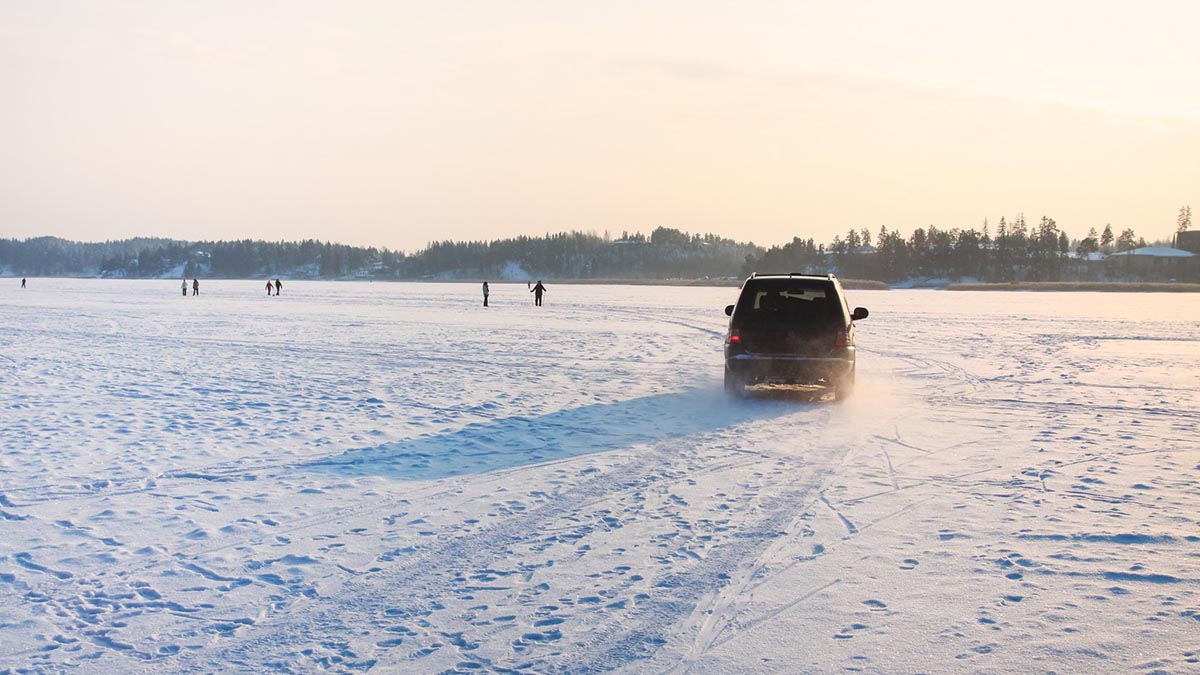Driving on ice
Ice cover shortens distances and enables transporting in archipelago in areas where it would be difficult to travel when the water is open. The quality and thickness of the ice determines how much it bears.

The bearing capacity of ice is determined by the effective ice thickness
Congelation ice is strong solid ice. It is calculated totally to the effective thickness of ice. Dark snow-ice is formed by freezing of condensed snow and water on the ice. If the dark snow-ice has frozen to the congelation ice, half of its thickness can be added to the effective ice thickness. If snow-ice has a light color, it can’t be taken into account at all. If the ice cover consists of two separate layers of ice with air in between, their thickness can’t be added together.
Cracks always reduce the bearing capacity of ice even if they do not extend through the whole ice column. At the edge of the crack, the carrying capacity of the ice is about half and at the crossing of cracks only about a quarter of the original capacity.
Effective ice thickness | Biggest allowed mass of the vehicle |
20 cm | 2,0 tons |
25 cm | 3,0 tons |
30 cm | 4,5 tons |
40 cm | 7,0 tons |
50 cm | 12,0 tons |
60 cm | 17,0 tons |
70 cm | 23,0 tons |
80 cm | 31,0 tons |
90 cm | 39,0 tons |
100 cm | 48,0 tons |
105 cm | 60,0 tons |
Source: The Centre for Occupational Safety (in Finnish)
The driving speed should be slow on ice
When driving a vehicle on ice, the bearing capacity is affected not only by the ice thickness but also by the wave motion generated to the water under the ice. Bearing capacity is at its weakest when the speed of the vehicle is the same as the speed of the wave, since the edge of the wave becomes so steep that it can break the ice. There is not such a problem if the speed of the vehicle is slower than the wave speed.
Ice thickness | 3 m deep water | 5 m deep water | 10 m deep water | 20 m deep water |
25 cm | 22 km/h | 28 km/h | 34 km/h | 36 km/h |
50 cm | 23 km/h | 29 km/h | 38 km/h | 45 km/h |
To ensure a safe transportation on ice, driver must be aware of ice conditions and thickness of the ice in the area. It is safest to use only marked ice roads by car.
While driving on an ice road, it is important to keep a safe distance to other vehicles. The length of the safe distance is difficult to determine, but vehicles should always keep at least 50 meters in between them while driving.
Due to the wave motion of water and ice, the latter vehicle is more likely to sink through the ice than the one driving in the front. Driving speed should always be decreased when there are other vehicles on the ice.
When approaching a shore, the driving speed must be less than 20 km/h and the shoreline must be crossed at a crawling speed. Close to the shore, the wave motion can be reflected from the shore, leaving the vehicle in a cross-wave under the ice crust, which can lead to the ice breaking under the vehicle. In places where the ice may be hanging on the shore and rocks, one must drive slowly.

